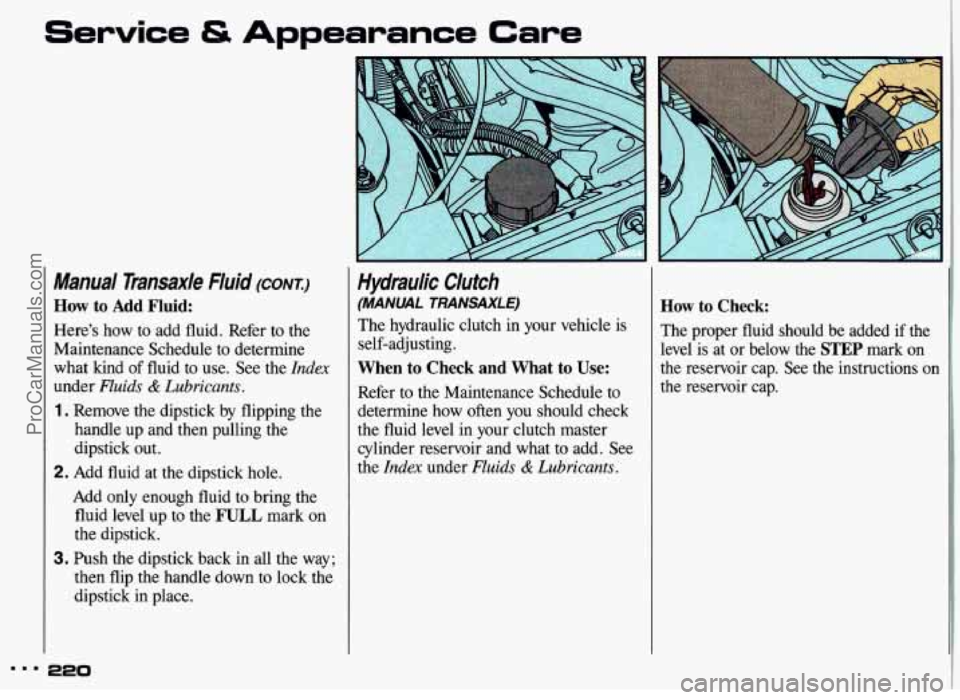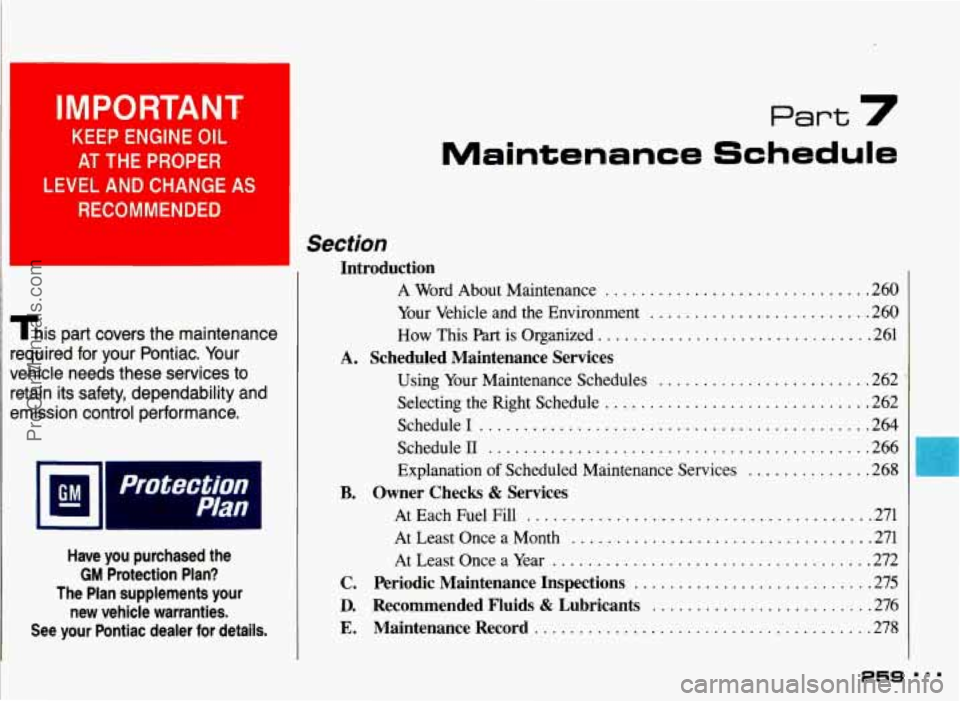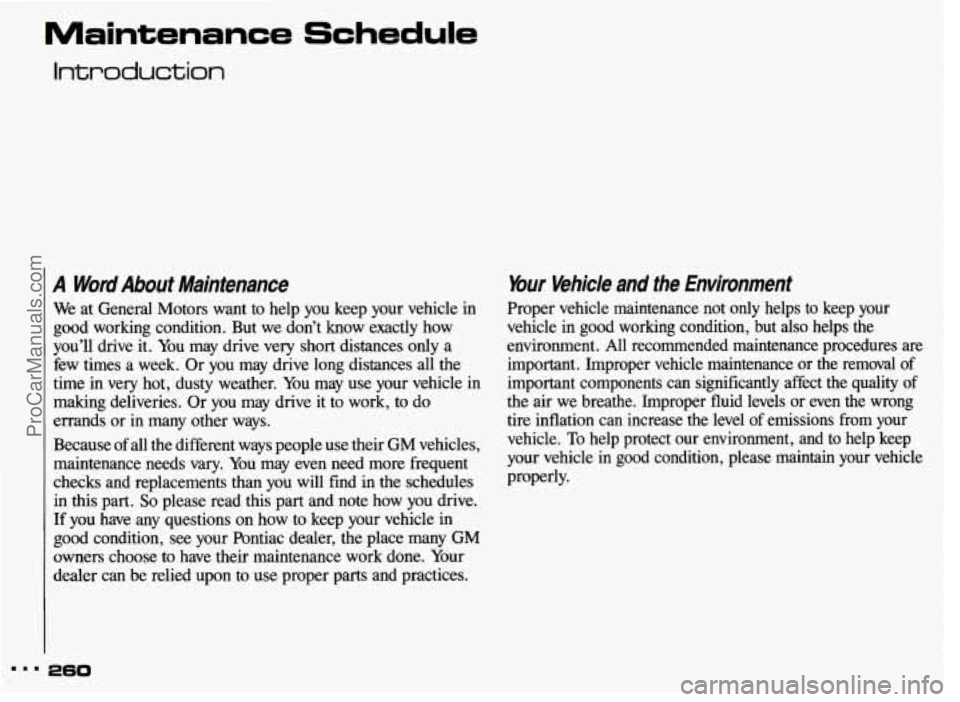Page 219 of 306

Service & Appearance Care
Automatic Transaxle Fluid (CONT.)
How To Add Fluid:
Refer to the Maintenance Schedule to
determine what kind of transaxle fluid to
use. See the
Index under Fluids &
Lubricants.
If the fluid level is low, add only enough
of the proper fluid to bring the level into
the cross-hatched area on the dipstick.
It doesn’t take much fluid, generally less
than a pint. Don’t overfill. We
recommend you use only fluid
labeled DEXRON@-IIE, because fluids
with that label are made especially for
your automatic transaxle. Damage caused by fluid other than
DEXRON@-IIE is not covered by your
new vehicle warranty.
After adding fluid, recheck the fluid
level as described under
How tu Check.
When the correct fluid level is obtained,
push the dipstick back in all the way.
Manual Transaxle Fluid
When to Check:
A good time to have it checked is when
the engine oil is changed. However, the
fluid in your manual transaxle doesn’t
require changing.
How to Check:
Because this operation can be a little
difficult, you may choose to have this
done at a Pontiac dealership Service
Department.
If you do it yourself, be sure to follow
all the instructions here, or you could
get a false reading on the dipstick.
m.. 218
ProCarManuals.com
Page 221 of 306

Service & Appearance Care
Manual Transaxle Fluid (CONI)
How to Add Fluid:
Here’s how to add fluid. Refer to the
Maintenance Schedule to determine
what kind
of fluid to use. See the Index
under Fluids & Lubricants.
1. Remove the dipstick by flipping the
handle up and then pulling the
dipstick out.
2. Add fluid at the dipstick hole.
Add
only enough fluid to bring the
fluid level up to the
FULL mark on
the dipstick.
3. Push the dipstick back in all the way;
then flip the handle down to lock the
dipstick in place.
220
Hydraulic Clutch
(MANUAL TRANSAXLE)
The hydraulic clutch in your vehicle is
self-adjusting.
When to Check and What to Use:
Refer to the Maintenance Schedule to
determine how often you should check
the fluid level in your clutch master cylinder reservoir and what to add. See
the
Index under Fluids & Lubricants.
How to Check:
The proper fluid should be added if the
level is at or below the
STEP mark on
the reservoir cap. See the instructions on
the reservoir cap.
ProCarManuals.com
Page 225 of 306
Service & Appearance Care
Power Steering Fluid
How to Check Power Steering Fluid:
Unscrew the cap and wipe the dipstick
with a clean rag. Replace the cap and
completely tighten
it. Then remove the
cap again and look at the fluid level
on
the dipstick.
When the engine compartment is hot,
the level should be at the
H (Hot)
mark.
the level should be at the
C (Cold)
mark.
When the engine compartment is cool,
What to Add:
Refer to the Maintenance Schedule to
determine what kind
of fluid to use. See
the
Index under Fluids & Lubricants.
Windshield Washer Fluid
To Add:
Open the cap labeled WASHER FLUID
ONLY.
Add washer fluid until the bottle is full.
mmm 224
ProCarManuals.com
Page 234 of 306
When to Check:
Check your tires once a month or more.
Don’t forget your compact spare tire. It
should be at
60 psi (420 kPa).
How to Check:
Use a good quality pocket-type gage to
check tire pressure. Simply looking at
the tires will not tell you the pressure,
especially if you have radial tires-
which may look properly inflated even if
they’re underinflated.
If your tires have valve caps, be sure to
put them back on. They help prevent
leaks by keeping out dirt and moisture.
lire inspection and Rotation
To make your tires last longer, have
them inspected and rotated at the
mileages recommended
in the Mainte-
nance Schedule. See the
Index under
Scheduled Maintenance Sewices .
Use this rotation pattern.
After the tires have been rotated, adjust
the front and rear inflation pressure as
shown
on the Tire-Loading Infomation
label. Make certain that all wheel
nuts
are properly tightened. See the Index
under Wheel Nut Torque.
233 .
ProCarManuals.com
Page 247 of 306

Finish Damage
Any stone chips, fractures or deep
scratches in the finish should be
repaired right away. Bare metal will
corrode quickly and may develop into a
major repair expense,
Minor chips and scratches can be
repaired with touch-up materials
available from your dealer or other
service outlets. Larger areas of finish
darnage can be corrected
in your
dealer’s body and paint shop.
Underbody Maintenance
Chemicals used for ice and snow
removal and dust control can collect on
the underbody. If these are not removed,
accelerated corrosion (rust) can occur
on the underbody parts such as fuel
lines, frame, floor pan, and exhaust system even though they have corrosion
protection.
At least every spring, flush these
materials from the underbody with plain
water. Clean any areas where mud and other debris can collect. Dirt packed in
closed areas of the frame should be
loosened before being flushed. Your
dealer or
an underbody vehicle washing
system can do this for you.
Chemical Paint Spotting
Some weather and atmospheric
conditions can create a chemical fallout.
Airborne pollutants can fall upon and
attack painted surfaces on your vehicle.
This damage can take two forms:
blotchy, ringlet-shaped discolorations,
and small irregular dark spots etched into the paint surfhce.
Although no defect in the paint job
causes this, Pontiac will repair, at no
charge to the owner, the surfaces of new
vehicles damaged
by this fallout
condition within
l2 months or l2,OOO
miles (20 OOO km) of purchase,
whichever comes first.
ProCarManuals.com
Page 258 of 306
Normal Maintenance Replacement ?bts
Air Cleaner Element
2.3L Quad OHC and Quad 4 ....... AC Type A-ll72C
3300 V6
....................... AC Type A-974C
Engine Oil Filter
2.3L Quad OHC and Quad 4 ....... AC Type PF-1225
3300 V6
....................... AC Type PF-47
3300 V6
..................... AC Type CV-899C
PCV Valve
Spark Plugs
2.3L Quad OHC and Quad 4 ........ AC Type .FR3LSK*
Gap: 0.035 inch (389
mm)
Gap: 0.035 inch (A89 mm)
Gap: 0.060 inch (1.52 mm)
2.3L Quad High Output. .......... AC Type *FR2LSK*
3300 V6 ....................... AC Type 41-600
*These spark plugs are made with special thread plating and spark plug boot release agents that may help prevent
damage to your aluminum cylinder head and spark plug wiring.
257 . .
ProCarManuals.com
Page 260 of 306

3 IMPORTANT
KEEP ENGINE OIL
AT THE PROPER
LEVEL AND CHANGE AS
RECOMMENDED
This part covers the maintenance
required for your Pontiac
. Your
vehicle needs these services to
retain its safety. dependability and
emission control performance
.
Section
Part 7
Maintenance Schedule
Have you purchased the
GM Protection Plan?
The Plan supplements your new vehicle warranties
.
See your Pontiac dealer for details .
Introduction
A Word About Maintenance ............................ 260
Your Vehicle and the Environment
......................... 260
How This Part is Organized ............................... 261
Using Your Maintenance Schedules
........................ 262
Selecting the Right Schedule
.............................. 262
Schedule1
............................................ 264
ScheduleII
......................................... 266
Explanation
of Scheduled Maintenance Services . . ... 268
A . Scheduled Maintenance Services
B . Owner Checks & Services
AtEachFuelFill ....................................... 271
At Least Once a Month
.................................. 271
At Least Once a Year
.................................... 272
C . Periodic Maintenance Inspections ........................... 275
D . Recommended Fluids & Lubricants ......................... 276
E . MaintenanceRecord ...................................... 278
259
ProCarManuals.com
Page 261 of 306

Maintenance Schedule
Introduction
A Word About Maintenance
We at General Motors want to help you keep your vehicle in
good working condition. But we don’t know exactly how
you’ll drive
it. You may drive very short distances only a
few times a week. Or you may drive long distances all the
time in very hot, dusty weather. You may use your vehicle in
making deliveries. Or you may drive it to work, to do
errands or
in many other ways.
Because of all the different ways people use their GM vehicles,
maintenance needs vary. You may even need more frequent
checks and replacements than you will find in the schedules
in this part. So please read this part and note how you drive.
If you have any questions on how to keep your vehicle in
good condition, see your Pontiac dealer, the place many GM
owners choose to have their maintenance work done. Your
dealer can
be relied upon to use proper parts and practices.
Your Vehicle and the Environment
Proper vehicle maintenance not only helps to keep your
vehicle in good working condition, but also helps the environment. All recommended maintenance procedures are
important. Improper vehicle maintenance or the removal of
important components can significantly affect the quality of
the air we breathe. Improper fluid levels
or even the wrong
tire inflation can increase the level of emissions from your
vehicle.
To help protect our environment, and to help keep
your vehicle in good condition, please maintain your vehicle
properly.
ProCarManuals.com